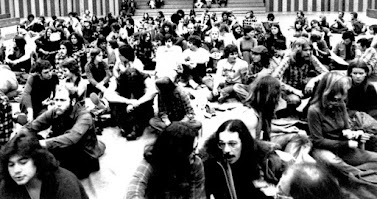Have you ever paused and tried to imagine what your parents were doing at the same age?
Last Friday night I tried to imagine them at the Brian
Wilson / Chicago concert we were sweating through at the Dos Equis Pavilion in
Dallas. It was an enjoyable outdoor show held in intolerable heat. The audience
was full of 50 and 60 somethings with a sprinkling of 70 somethings to see
Brian Wilson – who turned 80 this week.
The whole affair reminded me of an old Mad Magazine cartoon
that showed the 50th Woodstock Festival reunion attendees with canes
and walkers. It was a joke to the
teenage readers in 1970 but it hit home Friday night as fans sang along with
Beach Boys tunes that were blaring out of their transistor radios in 1963.
Maybe the concert should have been billed as the Medicare Advantage Tour.
I can’t poke too much at the crowd since I am a
card-carrying member of the Medicare generation myself. I like all sorts of live music but especially
enjoy classic rock shows. I checked off a big one last November with the
Rolling Stones show in Las Vegas. There was a predictable number of grey-haired
ponytails but the surprise to me was the large number of kids/teens in the
audience. Many were accompanied by their parents – or grandparents, who were
anxious to show them what a big rock show was all about. The Rolling Stones did
not disappoint and put on a great performance. Did I mention Mick Jagger turns
79 next month?
So, getting back to my parents…I could not imagine them
attending any concert, even Frank Sinatra, at this age. Instead, I could imagine my father driving us
to Roosevelt Stadium (NJ) for a concert and patiently waiting in the car to
drive us home. “Come on inside dad, Pink Floyd is a really cool band – you
should check them out!” That wasn’t
going to happen.
My parents weren’t prudes and accepted the fact that our
music wasn’t their music. They also appreciated the comfort of a recliner and a
television over big noise and big crowds. Concerts were not common in the
1930’s when my parent’s taste’s for music were being formed. It was the
depression and large venues didn’t exist outside of the major cities. Big bands
like Benny Goodman and Glenn Miller dominated the radio but they usually
performed in ballroom settings, not major concert halls. The big guys like Frank and Elvis and the
Beatles took it to a new level. Tens of
thousands of people wanted to see them perform and concert mania was born.
I’ve taken my kids
and kids in-law to classic rock concerts.
In turn they have invited me to their shows and still do. Some are hits and some are misses. I imagine the kids would say the same thing
but at least we all have a better understanding of what’s going through those
earbuds. Rock on dad.
Send comments to Flipsidecolumn@gmail.com.




